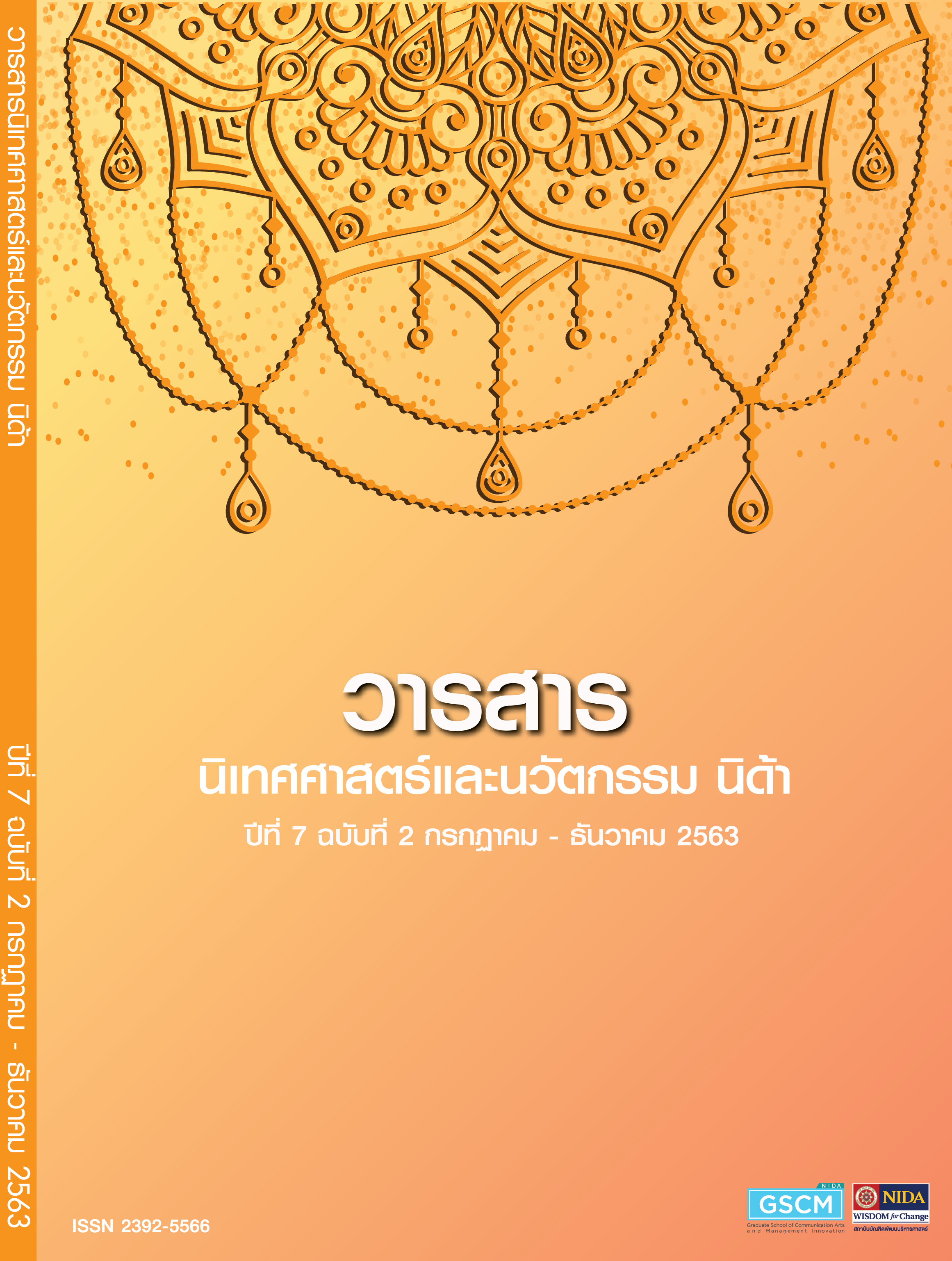พฤติกรรมผู้บริโภคและค่านิยมทางวัฒนธรรมผ่านการบริโภค สินค้าซานริโอ้ลายกุเดทามะของคนไทย
Main Article Content
บทคัดย่อ
งานวิจัยนี้มีวัตถุประสงค์เพื่อศึกษาพฤติกรรมการบริโภคสินค้าแบรนด์ซานริโอ้ลายกุเดทามะของคนไทยตลอดจนเพื่อศึกษาค่านิยมของคนไทย และ คนญี่ปุ่นผ่านการบริโภคสินค้าซานริโอ้ โดยใช้การวิเคราะห์เนื้อหา การสัมภาษณ์เชิงลึก และ การวิจัยเชิงเอกสาร ในการเก็บรวบรวมข้อมูลเพื่อ นำมาวิเคราะห์พฤติกรรมการบริโภคของคนไทย และ เปรียบเทียบความแตกต่างทางด้านค่านิยม วัฒนธรรม และ ความเชื่อระหว่างคนไทยกับคนญี่ปุ่นที่สื่อสารผ่านตัวการ์ตูนกุเดทามะ
จากการวิจัยพบว่า คนไทยที่นิยมสินค้าลายกุเดทามะมีพฤติกรรมการบริโภคเพราะกุเดทามะสามารถสะท้อนความเป็นตัวตนของผู้บริโภคได้เนื่องจากตัวการ์ตูนกุเดทามะที่มีความขี้เกียจ ชื่นชอบความสบาย ไม่ตามใจใคร เหมือนเป็นสื่อกลางให้คนรอบข้างเข้าใจถึงลักษณะนิสัยของตัวเรา โดยจะคำนึงถึงราคาเป็นอันดับแรกในการตัดสินใจซื้อก่อนจะดูที่รูปลักษณ์ที่ชื่นชอบเป็นลำดับต่อมา ในด้านของความแตกต่างทางค่านิยม วัฒนธรรม และ ความเชื่อของคนไทยกับคนญี่ปุ่นพบว่ามีความคล้ายคลึงกันเนื่องจากมีพื้นฐานคำสอนเหมือนกันจึงทำให้มีค่านิยมบางประการที่ตรงกันอย่างเช่น ค่านิยมการอยู่ร่วมกันในสังคม การกำหนดเป้าหมายในชีวิต เป็นต้น ส่วนค่านิยมที่แตกต่างกันคือ ค่านิยมการตรงต่อเวลา การเคร่งครัดในการทำงาน ในด้านวัฒนธรรมมีความเหมือนกันตรงที่มีการเปิดรับวัฒนธรรมมาจากประเทศอื่นอย่างหลากหลายก่อนจะนำมาเปลี่ยนแปลงให้เข้ากับวัฒนธรรมของตัวเอง อาจะมีต่างกันในบางวัฒนธรรมขึ้นอยู่กับขนบธรรมเนียมประเพณีเช่นวัฒนธรรมการกิน การแต่งกายเป็นต้น สุดท้ายคือเรื่องของความเชื่อในเรื่องของวิญญาณที่ตรงกันทั้งสองประเทศ
Article Details
ข้อความและความเห็นในวารสารนิเทศศาสตร์และนวัตกรรม นิด้า เป็นของผู้เขียนแต่ละท่าน มิใช่ของคณะนิเทศศาสตร์และนวัตกรรมการจัดการ สถาบันบัณฑิตพัฒนบริหารศาสตร์
เอกสารอ้างอิง
ณัฐณิชา วัฒนพานิช. (2552). การเปิดรับวัฒนธรรมป็อปของวัยรุ่นไทยจากสื่อมวลชนและแรงจูงใจในการเรียนภาษาญี่ปุ่น. วิทยานิพนธ์นิเทศศาสตรมหาบัณฑิต, จุฬาลงกรณ์มหาวิทยาลัย.
ณัฐพงศ์ ไชยวานิชย์ผล. (2017). ชินโต : ศาสนา วิญญาณ ธรรมชาติ และการถูกใช้เป็นเครื่องมือในสงคราม. สืบค้นจาก https://thematter.co/thinkers/all-about-shinto-and-kami/24878
เบญจรัสย์ เนตรนุช. (2552). ปัจจัยทางสังคมที่มีความสัมพันธ์กับกระแสความนิยมวัฒนธรรมญี่ปุ่นของนักเรียนชั้นมัธยมศึกษาตอนปลาย กรณีศึกษา โรงเรียนนวมินทราชินูทิศ หอวังนนทบุรี. วิทยานิพนธ์ศิลปศาสตร์มหาบัณฑิต, มหาวิทยาลัยเกษตร์ศาสตร์.
พรนภัส ชำนาญค้า. (2560). เคล็ดลับความป๊อปของ Gudetama จากไข่ขี้เกียจที่แพ้การประกวดสู่ผู้เผยแพร่วัฒนธรรมคาวาอิสุดฮิตในอเมริกา. สืบค้นจาก https://thestandard.co/culture-art-and-design-gudetama-story/.
พิมลพรรณ อิศรภักดี. (2014). ทัศนคติของคนรุ่นใหม่เกี่ยวกับการแต่งงานและมีบุตร. สืบค้นจาก http://www.ipsr.mahidol.ac.th/ipsr/AnnualConference/ConferenceX/Download/PPT/11-Pimonpan- AttitudesYoungPeople_1July2014.pdf
วาสนา ปานนวม. (2555). การส่งเสริมการ์ตูนของญี่ปุ่น : เครื่องมือเพิ่ม Soft Power และ ผลประโยชน์ทาง. เศรษฐกิจ. วารสารญี่ปุ่นศึกษา, 29(1), 76-85
Chibi-angle. (2016). จิตวิญญาณของนักสู้: เบื้องหลังคำว่า “กัมบัตเตะ” ของคนญี่ปุ่น. สืบค้นจาก https://anngle.org/th/j-culture/ganbatte.html
Fayossy. (2015). Top 10 ประเทศ ที่มีนักเล่นเกมส์มากที่สุด. สืบค้นจาก https://www.marketingoops.com/reports/behaviors/top-10-countries-play-game/
Getnihongo. (2016). คนญี่ปุ่นระเบียบวินัยสูง!!!. สืบค้นจาก https://www.facebook.com/GetNihongo/posts/752242454917464
Honestdocs. (2019). 10 ความเชื่อ (ผิด ๆ) เกี่ยวกับฝาแฝด. สืบค้นจาก https://www.honestdocs.co/myths-about-multiples
Lee, S. (2009). South Korea’s Soft Power Diplomacy. EAI Issue Briefing No. MASI 2009-01
McGray, D. (2002). Japan’s Gross National Cool. Foreign Policy, 130(130), 45-54.
Suzuki, N. (2008). Japanization in Thailand in the age of globalization. The 10th International Conference on Thai Studies, January 9-11. Bangkok: Thai Khadi Research Institute, Thammasat University.
Santos, A.A. (2017). How Gudetama, a lazy egg yolk with a butt, became an unstoppable cultural phenomenon. สืบค้นจาก https://www.vox.com/2017/4/3/14685348/gudetama-sanrio-hello-kitty-explained.
Yazdani, H. & Ahmadian,M. (2013). A Study of the Effects of Intertextuality Awareness on Reading Literary Texts: The Case of Short Stories1. Journal of Educational and Social Research, 3(2), 155-166


